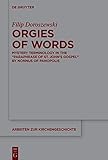Orgies of Words : Mystery Terminology in the “Paraphrase of St. John’s Gospel” by Nonnus of Panopolis / Filip Doroszewski.
Material type: TextSeries: Arbeiten zur Kirchengeschichte ; 154Publisher: Berlin ; Boston : De Gruyter, [2022]Description: 1 online resource (XV, 199 p.)Content type:
TextSeries: Arbeiten zur Kirchengeschichte ; 154Publisher: Berlin ; Boston : De Gruyter, [2022]Description: 1 online resource (XV, 199 p.)Content type: - 9783110790856
- 9783110790979
- 9783110790900
- BS2617.N663 D6713 2022
- online - DeGruyter
- Issued also in print.
| Item type | Current library | Call number | URL | Status | Notes | Barcode | |
|---|---|---|---|---|---|---|---|
 eBook
eBook
|
Biblioteca "Angelicum" Pont. Univ. S.Tommaso d'Aquino Nuvola online | online - DeGruyter (Browse shelf(Opens below)) | Online access | Not for loan (Accesso limitato) | Accesso per gli utenti autorizzati / Access for authorized users | (dgr)9783110790900 |
Frontmatter -- Acknowledgements -- Contents -- Foreword -- Foreword to the English translation -- Abbreviations -- Part 1: Introduction -- 1.1 Ancient mysteries -- 1.2 Mystery terminology -- 1.3 Nonnus of Panopolis -- 1.4 The scope of inquiry -- 1.5 Mystery terminology in the Paraphrase -- Part 2: Jesus and Dionysus -- 2.1 The wedding at Cana of Galilee -- 2.2 The failed arrest attempt -- 2.3 Jesus’ High Priestly Prayer -- Part 3: Mysterium and mysteries -- 3.1 The three Passover feasts -- 3.2 Jesus and the Samaritan woman -- 3.3 The Feast of the Tabernacles -- Part 4: Conclusions -- 4.1 The role of mystery terminology in the Paraphrase -- Bibliography -- Index graecitatis -- Index locorum -- Index nominum
restricted access online access with authorization star
http://purl.org/coar/access_right/c_16ec
Nonnus’ Paraphrasis, an epic rendition of the Fourth Gospel, offers a highly sophisticated interpretation of the Johannine text. An essential means to this end is extensive use of the imagery related to Greek, and especially Dionysiac, mysteries. Doroszewski successfully challenges the once predominant view that the mystery terminology in the poem is nothing more than rhetorical ornament. He convincingly argues for an important exegetical role Nonnus gives to the mystery terms. On the one hand, they refer to the Mystery of Christ. Jesus introduces his followers into the new dimension of life and worship that enables them to commune with God. This is portrayed as falling into Bacchic frenzy and being initiated into secret rites. On the other hand, the terminology has a polemical function, too, as Nonnus uses it to present the Judaic cult as bearing the hallmarks of pagan mysteries. As the book discusses the Paraphrasis against the background of the mystery metaphor development in antiquity, it serves as an excellent introduction to this key feature of the ancient mentality and will appeal to all interested in the culture of Imperial times, especially in Early Christianity, Patristics, Neoplatonism and Late Antique poetry.
Issued also in print.
Mode of access: Internet via World Wide Web.
In English.
Description based on online resource; title from PDF title page (publisher's Web site, viewed 02. Mai 2023)


